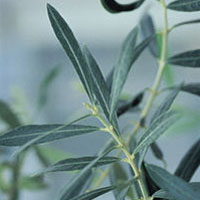
A-Z Indexes Food Health Guides
Health News |
Olive LeafFind ProductsAlso indexed as:Olea europa  © Martin Wall © Martin WallBotanical names: Olea europaHow It WorksOlive leaf has a wide number of constituents, including oleuropein and several types of flavonoids (e.g., rutin, apigenin, luteolin).5 While olive leaf is traditionally associated with a wide number of medicinal claims, few of these have been verified by experimental study. In an animal study oleuropein (when given by injection or in intravenous form) was found to decrease blood pressure (e.g., systolic and diastolic) and dilate the coronary arteries surrounding the heart.6 This ability to lower blood pressure may justify the traditional use of olive leaf in the treatment of mild to moderate hypertension.7 However, human studies are needed to clearly establish olive leaf as a potential treatment for high blood pressure. In addition, a test tube study has revealed that oleuropein inhibits the oxidation of LDL (“bad”) cholesterol. LDL oxidation is one part in a series of damaging events that, if left unchecked, can lead to the development of atherosclerosis.8 This action may provide one clue as to why those consuming a Mediterranean-based diet may lower their risk of developing atherosclerosis. Oleuropein from olives may also have antibacterial properties. When unheated olives are brined to preserve them, oleuropein is converted into another chemical called elenolic acid. Elenolic acid has shown antibacterial actions against several species of Lactobacilli and Staphylococcus aureus and Bacillus subtilus in a test tube study.9 Whether or not the oleuropein in the leaf undergoes such a transformation is open to question at this point, raising some question as to its antibacterial effects and potential use for this purpose in humans. Olive leaf extracts have been employed experimentally to lower elevated blood-sugar levels in animals with diabetes.10 These results have not been reproduced in human clinical trials and as such, no clear conclusions can be made from this animal study in the treatment of diabetes. How to Use ItThe effective amount of olive leaf for human use is not established. To make a tea, steep 1 teaspoon (5 grams) of dried leaves in 1 cup (250 ml) of hot water for 10–15 minutes.11 Dried leaf extracts containing 6–15% oleuropein are available commercially, but no standard amount has been established. Copyright © 2026 TraceGains, Inc. All rights reserved. Learn more about TraceGains, the company. The information presented by TraceGains is for informational purposes only. It is based on scientific studies (human, animal, or in vitro), clinical experience, or traditional usage as cited in each article. The results reported may not necessarily occur in all individuals. Self-treatment is not recommended for life-threatening conditions that require medical treatment under a doctor's care. For many of the conditions discussed, treatment with prescription or over the counter medication is also available. Consult your doctor, practitioner, and/or pharmacist for any health problem and before using any supplements or before making any changes in prescribed medications. Information expires December 2026. |
